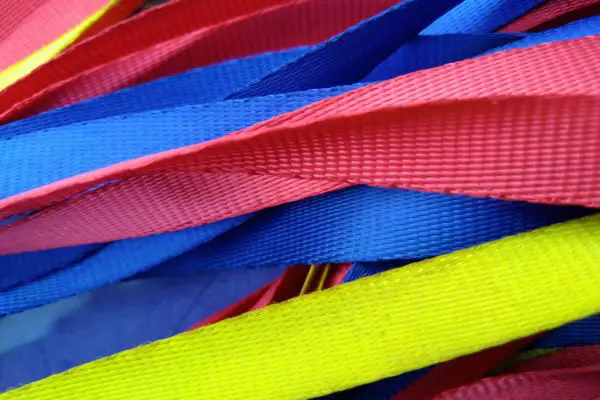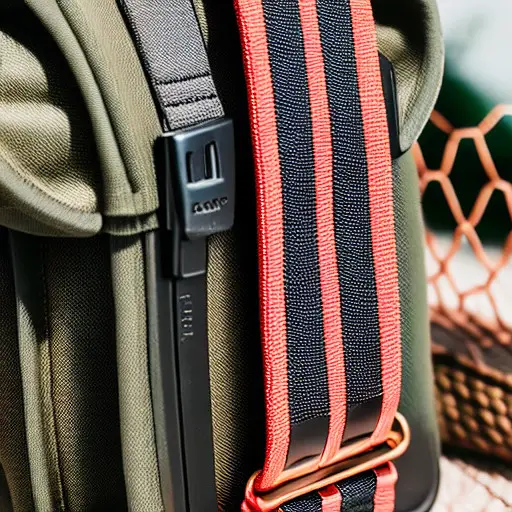Nylon straps are a great way to secure your outdoor gear, but when they get too tight or fray over time, it can be frustrating. If you’re tired of dealing with stiff nylon straps that don’t budge, this article is for you!
To soften nylon straps, follow these steps:
1. Wash the straps: Hand wash the nylon straps in warm soapy water using a mild detergent. Gently rub the straps together to help loosen any stiffness. Rinse thoroughly with clean water and avoid twisting or wringing the straps.
2. Fabric softener: Add a small amount of fabric softener to a bucket of warm water and soak the nylon straps for 15-30 minutes. This will help to soften the fibers and make them more pliable. Rinse the straps thoroughly to remove any residue.
3. Dry the straps: Hang the nylon straps to air dry, avoiding direct sunlight as it can cause the straps to fade or become brittle. Do not use a dryer, as the heat can damage the nylon fibers.
4. Massage the straps: Once the straps are dry, gently massage and flex them to help break up any remaining stiffness. You can also roll the straps between your hands or use a soft cloth to rub them.
5. Use a nylon brush: Gently brush the straps with a soft nylon brush to help soften the fibers and remove any remaining stiffness.
6. Repeat the process: If the straps are still too stiff after following these steps, repeat the process as needed until the desired softness is achieved.
Remember that nylon straps will naturally soften over time with regular use, so be patient and allow the material to break in naturally.
Not only will softening the straps make them more comfortable to use, but it will also help extend their life expectancy. With just a few simple steps, you’ll have softer straps in no time – giving you more peace-of-mind as you explore the outdoors without worrying about discomfort or fraying.
So let’s get started!
What is nylon and why is it used for straps?
Nylon is a synthetic material known for its durability, and it has become increasingly popular in the outdoor industry. Its ability to stand up to wear and tear makes it a great choice compared with other materials like cotton or polyester; not only is nylon more resilient, but it also takes less of an environmental toll during manufacturing processes.

On top of that, nylon straps are usually much cheaper than their counterparts made from leather or metal.
Cleaning nylon straps can be tricky because harsh soaps and detergents could damage them. It’s best to avoid using abrasive sponges when cleaning nylon — better yet, use a damp cloth instead! Additionally, since nylon straps tend to cling to dirt and dust easily, you should clean them regularly using a mild soap solution.
With proper care and maintenance, your nylon straps will continue looking as good as new for years to come.
When used correctly and cared for properly, nothing beats the versatility of nylon straps — no matter what adventure you take on next! Whether you’re carrying heavy loads over rough terrain or going out into wet weather conditions, these durable materials provide reliable support without sacrificing comfort.
Now let’s look at different ways we can soften our trusty nylon straps even further…
Different Ways To Soften Nylon Straps
When it comes to caring for nylon straps, there are a variety of techniques that can be used to ensure your straps remain soft and comfortable. From knotting techniques to cleaning methods, each option offers its own level of expertise when it comes to the great outdoors.
But how exactly do you soften nylon straps?
Here’s a list of ways to make sure your nylon straps stay supple:
- Knotting Techniques: Utilizing various knotting techniques helps prevent premature wear-and-tear on the strap by evenly distributing stress along multiple points in the material.
- Cleaning Methods: Regularly cleaning with gentle soap and warm water will help remove dirt particles while also keeping dampness at bay – ensuring your materials last longer.
- Break In Periods: Taking breaks from heavy use is essential for any outdoor item; allowing the time off gives the strap an opportunity to recover from prolonged exposure to tension or strain.
- Sewing Solutions: Using a needle and thread is another way people have been known to extend their equipment’s lifespan – just remember not to pull too tightly as this could cause further damage down the line.
- Stretching Methods: Lastly, stretching out the material gradually over time can provide relief from tight knots or areas prone to rubbing against skin – giving you peace of mind during long hikes.
With these tips in mind, you’ll be able to keep your nylon straps soft without having worry about them deteriorating quickly!
Before moving onto our next section though, take all these solutions into consideration before attempting them yourself – understanding what works best for your situation is key in making sure they serve their purpose correctly.
Techniques To Avoid Over-Softening
When softening nylon straps, it’s important to be aware of a few techniques that could help you avoid over-softening.
One key tip is to consider the fabric type used in the construction of your strap – some fabrics may not hold up as well when softened repeatedly and could cause durability issues down the line.
Furthermore, depending on how often you soften or replace your straps, there can also be an environmental impact associated with it if done too frequently.
It’s also worth considering cost comparison between different types of maintenance tips for softening the straps; this will give you a better idea of what would work best for you from both a financial and practical standpoint.
Doing so will provide more insight into which option would be most suitable for extending the life span of your nylon straps without compromising their comfortability.
Ultimately, careful consideration needs to be taken when softening any kind of strap in order to ensure its continued effectiveness and longevity without sacrificing quality.
With these factors in mind, let’s move onto exploring the benefits of softening nylon straps.
Benefits Of Softening Nylon Straps
Making sure your nylon straps are properly softened can make a huge difference in how long they last and the level of comfort they provide.

It’s estimated that nearly 70% of all nylon strap chafing is caused by over-softening, so avoiding this misstep will give you years of use from your equipment.
Keeping your straps soft not only helps with avoiding chafing but also ensures you have access to safe materials for any activity where security or safety may be an issue.
Proper storage techniques, stretching exercises, and adjustable lengths are some of the key components to consider when softening your nylon straps.
Storing them away from heat sources like direct sunlight or radiators can help prevent them from becoming dry and brittle over time as well.
Additionally, there are special stretching techniques tailored specifically for each type of material which can greatly increase their lifespan while reinforcing strength and resilience.
Finally, look into adjustable length options if needed – having extra room when tightening the buckle allows for more flexibility without damaging the fabric itself.
Softening nylon straps offers many advantages – it reduces wear and tear on the webbing itself as well as prevents discomfort due to chafing during prolonged periods of movement.
With proper care and maintenance, these lightweight materials can offer robust support while allowing users to adjust tightness easily according to their needs.
Frequently Asked Questions
What Tools Are Needed To Soften Nylon Straps?
When it comes to softening up nylon straps, there are a few tools you’ll need.
Heat settings, friction techniques, iron types and dye colors all play an important role in determining the stiffness level of your strap’s material.
As an outdoor expert, I recommend manipulating these elements to create the perfect combination that will allow for maximum comfort during any journey.
From camping trips to extreme sports excursions, having a properly softened nylon strap can make all the difference when it comes to overall enjoyment!
What Is The Best Type Of Nylon To Use For Straps?
Have you ever wondered what is the best type of nylon to use for straps?
As an outdoor expert, I can tell you that it all depends on the weaving techniques, heat treatments, dyeing methods, knot tying and seam sealing used.
These are all important considerations when selecting a quality nylon for your straps.
Every single one of these elements will affect how comfortable, durable and water resistant your strap is – so make sure you choose wisely!
With the right materials and knowledge, you can create a strap with superior performance that gives both comfort and freedom.
How Long Does It Take To Soften Nylon Straps?
If you’re looking for a way to soften nylon straps that can handle heavy duty use, heat treatment or chemical softening is the best option.
Heat treatment will provide quick results while retaining strength and wear resistance; however, chemical softening takes longer but provides greater flexibility over time.
For those of us who crave freedom in our outdoor adventures, this process can be worth it as we don’t have to worry about our gear breaking down when faced with tough conditions.
Is It Possible To Over-Soften Nylon Straps?
It can be hard to find the right balance when softening nylon straps, as it is possible to over-soften them!
As an outdoor expert, I would suggest taking caution and using a combination of dyeing straps, stiffening methods, edging techniques, heat treatments and pressure points for optimal results.
Finding that perfect blend of all these elements will help you get the most out of your strap without overdoing it.
With a little patience and practice, you’ll be able to soften your nylon straps just enough while still maintaining their integrity.
Is Softening Nylon Straps An Expensive Process?
Softening nylon straps is not an expensive process, compared to the cost of investing in new straps.
With a few simple techniques and fabric selections, you can easily soften your existing straps with minimal time management or heat control.
By selecting the right type of fabric for your application, you will be able to save money by avoiding costly replacements while enjoying the freedom that comes from achieving a soft-to-the-touch strap.
Conclusion
Softening nylon straps is an easy process that doesn’t require any special tools or skills. With a few simple steps, you can make your straps softer and easier to use.
It’s like taking a stiff piece of rope and turning it into something soft and pliable – almost like string cheese! For those who are looking for the best type of strap material, nylon is ideal because it’s strong yet flexible enough for comfortable wear.
Plus, it takes relatively little time to soften up the straps compared to other types of materials. However, be sure not to over-soften them as this could cause damage or breakage in the future.
Overall, softening nylon straps isn’t costly or complicated – just remember to do so with care. Whether you’re using them for camping gear, backpacks, purses or anything else, by following these tips you’ll have sturdy yet comfortable straps for years to come.




